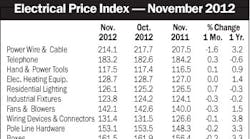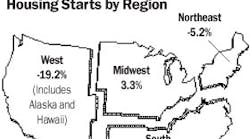Latest from Mag
People - Dec 21, 2012
Obituaries - Dec 21, 2012
November EPI Index Shows No Change
Housing Starts Dip 4% in November
Electrical Marketing - December 21, 2012
Around the Industry - Dec 21, 2012
A new business model that would radically change how Philips Lighting serves its professional and consumer retail market segments got a thumbs-up from distributor participants at the company’s recent distributor advisory council.
According to Erik Bouts, CEO and president, Philips Lighting Co., Somerset, N.J., distributor council participants endorsed the new strategy, which will create separate business divisions to support distributors in the company’s market segment and Home Depot in its consumer segment. Bouts said both market segments had been served by the same sales, marketing, MIS, logistics and executive personnel in the past.
Bouts, who became CEO of Philips Lighting after 16 years of experience in executive roles with other business units for Philips Lighting’s parent company Royal Philips Electronics, developed a business model that separates the consumer and professional segments and gives each its own sales, marketing, logistics and management information resources. Ed Crawford is senior vice president of the Philips Lighting professional market, and Bob Taylor is senior vice president of the company’s consumer market segment.
“Those two segments are different worlds,” Bouts said during an interview at last week’s LightFair. “There is nothing complementary — the way you go to market, product lineup, pricing or advertising. Each business unit now has its own marketing and sales force, logistics organization and warehousing.”
Philips distributors were sensitive about the company’s alliance with Home Depot and did not want to take a back seat to Big Orange, which now sells one of every five light bulbs in the United States. Bouts says with the old organization, Philips heard criticism that the company was “the Home Depot supply group.”
The company’s new business model has quieted some of those fears. “Home Depot is a very valued customer, but the world is bigger than Depot,” he said. “We wanted to show distributors we are dedicated to growing the business in the professional segment. How can we make that more clear than by setting up a dedicated professional organization? Home Depot now has its own self-sustaining unit within the Philips organization serving it. Their demands will not impact our service level and commitment to customers in our professional segment. That’s a big change.”
Key to the success of the new model will be localizing the company’s support services to electrical distributors across the United States. In its professional market segment, Philips Lighting now has four regional business zones. Electrical distributors within each zone will work with the sales, financial, marketing, MIS and logistics staff dedicated solely to that region.
“The distributor landscape is a very regional landscape,” said Bouts. “Every segment has its own characteristics, and you have to bring your marketing down to that level. You need to be more responsive, faster and more locally aligned with the local needs of electrical distributors.”
A big part of the new model is the development of local sales teams that will spend half their time calling on end users to drive business to distributors.
“We have to create sockets that our distributors can fill with our product,” Bouts said. “It’s not our role to build up inventory with distributors, and not have any place for them to sell it. We have local sales teams that in the past were focused on making sales calls on electrical distributors.
“But that’s only 50 percent of the job. Their real job is to bring new business to our distributors. To do that, we have established an end user sales force of 50 people nationwide organized into the four regions. Their only role is to make sales calls on end users and bring that business to distributors.”
Bouts says Philips Lighting’s new end-user sales force will often fly solo on sales calls, but they will also go on joint sales calls with distributor salespeople when it makes sense. Ultimately, he wants to create a “pull effect” in the electrical marketplace.
“Just pushing inventory into distributor warehouses doesn’t help anybody,” he said.

